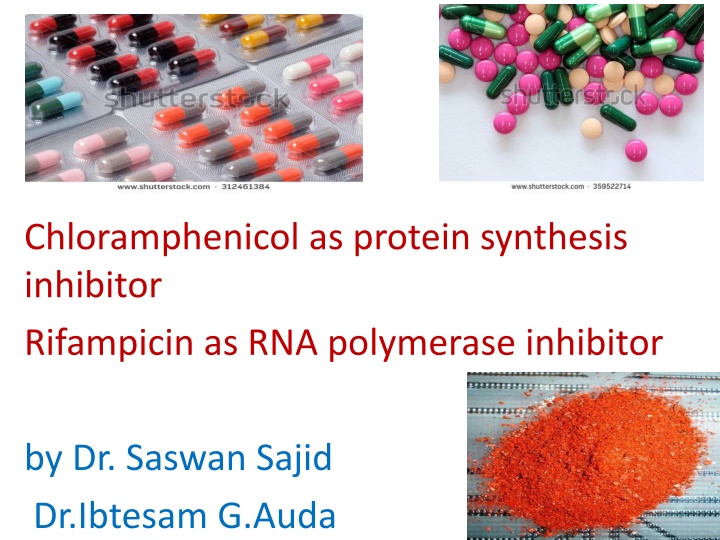
Rifampicin: Mechanism of Action, Resistance, and Adverse Effects
Rifampicin, a potent antibiotic derived from Amycolatopsis rifamycinica, inhibits bacterial DNA-dependent RNA polymerase, making it effective against tuberculosis, leprosy, and Legionnaire's disease. However, resistance can develop due to mutations in the rpoB gene. Combination therapy is crucial to prevent resistance and optimize treatment outcomes. Despite its effectiveness, rifampicin can cause hepatotoxicity and various side effects, such as gastrointestinal disturbances and bodily fluids turning orange-red. Understanding the mechanisms of action, resistance, and adverse effects of rifampicin is essential for its appropriate clinical use.
Download Presentation

Please find below an Image/Link to download the presentation.
The content on the website is provided AS IS for your information and personal use only. It may not be sold, licensed, or shared on other websites without obtaining consent from the author. If you encounter any issues during the download, it is possible that the publisher has removed the file from their server.
You are allowed to download the files provided on this website for personal or commercial use, subject to the condition that they are used lawfully. All files are the property of their respective owners.
The content on the website is provided AS IS for your information and personal use only. It may not be sold, licensed, or shared on other websites without obtaining consent from the author.
E N D
Presentation Transcript
Chloramphenicol as protein synthesis inhibitor Rifampicin as RNA polymerase inhibitor by Dr. Saswan Sajid Dr.Ibtesam G.Auda
Rifampicin, also known as rifampin is made from Amycolatopsis rifamycinica is an antibiotic used to treat a several types of bacterial infections. This includes tuberculosis, leprosy, and Legionnaire's disease. It is almost always used along with other antibiotics, except when given to prevent Haemophilus influenzae typ b and meningococcal disease in those who have been exposed to those bacteria Mechanism of action Rifampicin inhibiting bacterial DNA-dependent RNA polymerase. rifampicin binds to RNA polymerase at a site adjacent to the RNA polymerase active center and prevents RNA synthesis by physically blocking the formation of the phospho diester bond in the RNA backbone, preventing extension of RNA more than 2 to 3 nucleotides Mechanism of resistance Resistance to rifampicin arises from mutations that alter residues of the rifampicin binding site on RNA polymerase, rifampicin. Resistance mutations map to the rpoB gene, encoding the beta subunit of RNA polymerase Resistance in tuberculosis Mycobacterial resistance to rifampicin may occur alone or along with resistance to other first line anti-tubercular drugs. Early detection of such multi-drug or extensively drug-resistant tuberculosis is critical in improving patient outcomes by instituting appropriate second-line treatments, and in decreasing transmission of drug-resistant TB. Rifampicin can be used as mono therapy for a few days as prophylaxis against meningitis, but resistance develops quickly during long-term treatment of active infections, so the drug is always used against active infections in combination with other antibiotics. resulting in decreased affinity for
Spectrum of as pyrazinamide, isoniazid, and ethambutol . For the treatment of tuberculosis, it is administered daily for at least 6 months. Combination therapy is utilized both to prevent the development of resistance and to shorten the length of treatment. tuberculosis to rifampicin develops quickly when it is used without another antibiotic Rifampicin can be used alone in patients with latent tuberculosis infections to prevent the development of active disease because only small numbers of bacteria are present. Rifampicin is also used to treat non-tuberculous mycobacterial infections including leprosy (Hansen's disease) and Mycobacterium kansasii Rifampicin is sometimes used in the treatment of methicillin- resistant Staphylococcus aureus (MRSA) in combination with fusidic acid, including in difficult-to-treat infections such as osteomyelitis and prosthetic joint infections. of activity in :Rifampicin combination is used other for the treatment tuberculosis with antibiotics, such Resistance of Mycobacterium
Adverse effects The most serious adverse effect is hepatotoxicity.The more common side effects include fever, gastrointestinal immunological reactions. Taking rifampicin usually causes certain bodily fluids, such as urine, sweat, and tears, to become orange-red in color . Other adverse effects include: Liver toxicity hepatitis, liver failure in severe cases Respiratory breathlessness Cutaneous flushing, pruritus, rash, hyperpigmentation, redness and watering of eyes Abdominal nausea, vomiting, abdominal cramps, diarrhea Flu-like symptoms chills, fever, headache, arthralgia, and malaise. Rifampicin has good penetration into the brain, and this may directly explain some malaise and dysphoria in a minority of users. Allergic reaction rashes, itching, swelling of the tongue or throat, severe dizziness, and trouble breathing disturbances, rashes, and
Chloramphenicol synthesis. It prevents protein chain elongation by inhibiting the peptidyl transferase activity specifically binds to A2451 and A2452 residues in the 23S rRNA of the 50S ribosomal subunit, preventing peptide bond formation it is an antibiotic useful for the treatment of a number of bacterial infections.This includes as an eye ointment to treat conjunctivitis.it is used to treat meningitis, plague, cholera, and typhoid fever. Chloramphenicol was discovered from Streptomyces venezuelae in 1947. Its chemical structure was identified and it was first artificially made in 1949, making it the first antibiotic to be made instead of extracted from a micro- organism. Spectrum Chloramphenicol has a broad spectrum of activity and has been effective in treating ocular infections caused by a number of bacteria including Staphylococcus pneumoniae, and Escherichia against Pseudomonas aeruginosa. is a bacteriostatic by inhibiting protein of the bacterial ribosome. It after being isolated aureus, It Streptococcus not effective coli. is
Resistance Chloramphenicol resistance may be carried on a plasmid that also codes for resistance to other drugs . One example is the ACCoT plasmid (A=ampicillin, C=chloramphenicol, Co=co-trimoxazole, T=tetracycline), which mediates multiple drug resistance in typhoid (also called R factors).. Three mechanisms of resistance to chloramphenicol are known: 1- reduced membrane permeability, and this is the most common mechanism of low-level chloramphenicol resistance. 2- mutation of the 50S ribosomal subunit, ( are rare). 3- producing modifying enzyme acetyltransferase . High-level resistance is conferred by the cat-gene; this an enzyme called chloramphenicol acetyltransferase, which inactivates chloramphenicol by covalently linking one or two acetyl groups, derived from acetyl-S-coenzyme A, to the hydroxyl groups on the chloramphenicol molecule. The acetylation prevents chloramphenicol from binding to the ribosome. the chloramphenicol gene codes for
Adverse effects A plastic anemia The most serious side effect of chloramphenicol treatment This effect is rare and sometimes fatal. The effect usually occurs weeks or months after treatment has been stopped, and a genetic predisposition may be involved. Bone marrow suppression :Chloramphenicol suppression during treatment; this is a direct toxic effect of the drug on human mitochondria..It is fully reversible once the drug is stopped Leukemia:cancer of the blood or bone marrow,characterized by an abnormal increase of immature white blood cells. The risk of childhood leukemia is increased with length of treatment. Gray baby syndrome Intravenous chloramphenicol use has been associated with the so-called gray baby syndrome.This phenomenon occurs in newborn infants because they do not yet have fully functional liver enzymes (i.e. UDP-glucuronyl transferase), so chloramphenicol remains unmetabolized in the body. This causes several adverse effects, including hypotension and cyanosis. The condition can be prevented by using the drug at the recommended doses, and monitoring blood levels. Hypersensitivity reactions :Fever, macular and vesicular rashes, a urticaria, and anaphylaxis may occur. Neurotoxic reactions Headache, mild depression, mental confusion, peripheral neuritis have been reported, usually following long-term therapy. may cause bone marrow Optic and






















